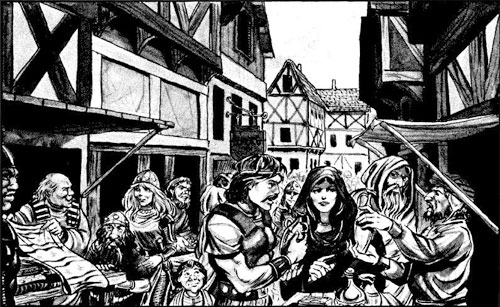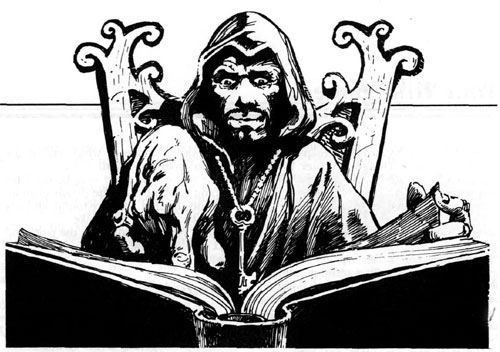I picked up my 4th edition Dungeons & Dragons books the day they came out. I couldn’t help it; it’s a weakness of mine. I read through the rules, formed a few opinions, and got a hankering to run a game. Problem was that my playgroup is already hip-deep in a 3rd edition Forgotten Realms game, and I didn’t want to rock the boat by taking the reins from our current DM. So I waited. And jotted down some notes here and there about some adventure ideas.
Then, for reasons I would just as soon not go into on a blog, our campaign hit a bump and our DM isn’t really available at the moment. So we cracked open the books and four of us sat down for our first actual 4e game together. Jimbo put together a tough-guy hammer-and-shield Fighter, Daniel brewed up a halfling Warlock (Infernal Pact), and Jasper finally settled on a Warlord after strongly considering making a Cleric.
The new rules were foreign enough to these three that making characters required a bit of explanation, quite a few questions, and more than a little guesswork. When all was said and done, we were able to create three characters hailing from a desperate little foothills town with a Goblin problem. It had taken us about half a game session to make the characters, so I wanted to get straight to the action: they were on their way into Goblin territory to scout out a temporary logging operation. Times are so rough in town that gathering firewood for the season amounts to a military operation. Two skirmishes followed, which gave us a chance to flex our muscles and throw around some dice. A few observations:
- I would have had a really hard time making Goblin Tactics and Tide of Iron make sense to everybody at the table if I weren’t using a battle mat. Miniatures weren’t necessary; I just used some scraps of paper and used the grid to keep track of where everything was.
- Assuring that the party worked well together was a no-brainer. I encouraged them to each have a different party role (defender, striker, and leader, respectively) and the core rules character abilities took care of the rest.
- The Warlord ability Commander’s Strike works wonders along with the Fighter’s Combat Challenge against a badguy that’s trying to disengage from the fight: Fighter takes a double-move to get into position, Warlord goads the Fighter into a free basic attack, and now the fleeing ranged baddie is stuck.
- The Fighter works differently than he used to. Lots more reasonable options in the heat of the moment. Jimbo has been playing Fighters since I was in preschool, and after a little initial hesitation was right on top of his newly-refined party role, using Cleave and Tide of Iron to mop up minions and break up wolfpack flanking maneuvers like nothing. The Fighter rules have changed a lot, but Fighters haven’t really changed at all from what we really think of them as.
- The Warlock worked a lot like I used to wish Magic Users would, back when I thought Evocation spells were really cool. A Warlock can blast away all day, every day, with his curses and Hellish Rebuke really doing the heavy lifting when it came to parting the bad guys from their hit points. That’s the whole point of a “striker” character class, but it seemed to work out better than just reading the books had implied.
- The Warlord suffered from bad die rolls. Really bad die rolls all night. This made his Commander’s Strike and Inspiring Word abilities all the more important; he could be useful when he was rolling twos and threes.
- Whipping up appropriately-challenging encounters was a breeze. About 100xp worth of bad-guys per first-level character made for a pretty easy scrap. Throwing in an encounter of 125xp critters (two gray wolves and a Goblin Sharpshooter) challenged the party enough to blow a handful of healing surges and dropped the Warlock into negative hit points (largely due to some very good die rolls on my part).
Overall, though I’m dismayed by the cause of the interruption in our 3rd edition game, I’m pleased with how this seriously-reworked new edition of Dungeons & Dragons worked out. I am highly interested in seeing what Privateer Press does with the system, if anything. The creation of new character classes strikes me as superficially labor-intensive, but there are a number of design features built into the new system that I think really help keep things on an even keel, particularly in the area of keeping characters of diverse themes useful.
Next time we have a 4e game session, I’ll have to try out the Skill Challenge system a bit. It is intended to make non-combat encounters a bit more playable within the rules framework (as opposed to a bunch of jibber-jabber finally resolved by a single die-roll by a single character), but the math just doesn’t look right to me. We’ll see what happens when we start throwing dice for determining the location of their logging camp. It’ll almost certainly be interesting, but statistically I’m betting that following the DMG’s guidance will lead to a failed encounter.


I was very happy with how the trial run of 4th edition went. It’s great to play a spell caster that can suck some damage and take some hit point loss, without looking for the nearest exit or meatshield.
I also liked how simple casting and managing spell lists was, when picking up a specific caster class for the very first time.
Don’t use complexity 1 skill challenges (4 successes, 2 failures), the math works out badly for the PCs then. All the other complexities work out fine.
@Daniel: Glad to hear it.
@Steamworks: I’m not sure I follow. A complexity 2 encounter requires 6 successes before 3 failures. If using the suggested difficulties for a “moderate” challenge, a character with 18 in the relevant attribute (+4) that is trained in the skill (+5) has to roll an 11 for a success (because the difficulty table basically advances at the same rate as +1/2 level bonus you get on skill checks, I’m leaving that out). 50:50 odds sound reasonable for a single roll, but over six rolls you have a 50:50 chance of failing out entirely having only reached half your goal.
Take that complexity 2 skill challenge (win 6 before losing 3), and assuming that every attempted skill check is by somebody with that 50:50 chance (that is to say, they don’t let the dumb guy make the History check or the wallflower make the Bluff check), the overall odds seem to drop from 19% (flip a coin: get heads four times before getting tails twice) to about 14% (flip a coin: get six heads before getting three tails).
1 success before 1 failure: 50%
4 successes before 2 failures: 19%
6 successes before 3 failures: 14%
8 successes before 4 failures: 11%
Using the numbers suggested in the DMG looks like a recipe for failure unless you forgo the +5 recommended difficulty for skill checks on that lovely DMG pg42 table, in which case the skill challenges get quite easy:
1 success before 1 failure: 75%
4 successes before 2 failures: 63%
6 successes before 3 failures: 68%
8 successes before 4 failures: 71%
Of course, that’s “quite easy” when the characters making the rolls are more-or-less optimized for the task at hand. Throw in some typical variance for characters with untrained skills, characters with more reasonable stats (maybe a 14 or 16 instead of that 18) and it starts looking pretty reasonable. I think we may have run into my first house rule here; it’s important that the players get a chance to make decisions that can lead to a reasonable chance of success (unless you’re trying to set them up for a dramatic setback, but that’s another matter).
Oh, I’m considering that a house rule because there are a couple concrete examples of how tough the writers intended these things to be. The Magic Crossbow Turret recommends a DC 20 Thievery check skill challenge of complexity 2 to disarm (6 successes before 3 failures), and that’s a level 3 trap; theoretically an appropriate challenge for a 3rd level party, and the way the math looks to me, the party Thievery expert has about a 14% chance of making it work.
The fact that most of our player rolls were utter crap didn’t help things any. I know for a fact 90% of my rolls were under 10.
@Daniel I am glad my legacy lives on.
Pingback: Skill Challenge Errata » Burrowowl